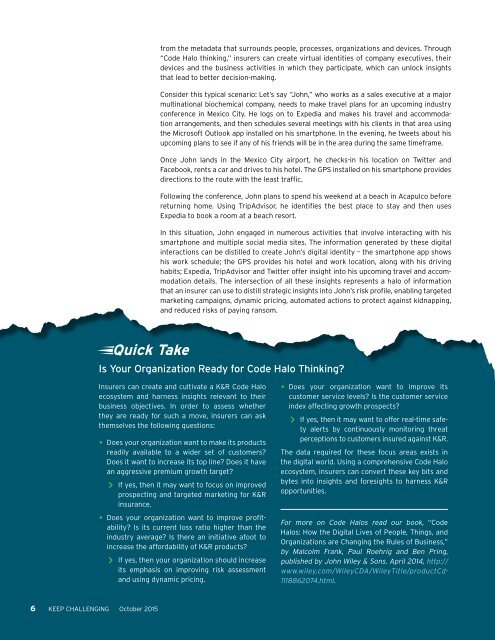You also want an ePaper? Increase the reach of your titles
YUMPU automatically turns print PDFs into web optimized ePapers that Google loves.
from the metadata that surrounds people, processes, organizations <strong>and</strong> devices. Through<br />
“Code Halo thinking,” insurers can create virtual identities of company executives, their<br />
devices <strong>and</strong> the business activities in which they participate, which can unlock insights<br />
that lead to better decision-making.<br />
Consider this typical scenario: Let’s say “John,” who works as a sales executive at a major<br />
multinational biochemical company, needs to make travel plans for an upcoming industry<br />
conference in Mexico City. He logs on to Expedia <strong>and</strong> makes his travel <strong>and</strong> accommodation<br />
arrangements, <strong>and</strong> then schedules several meetings with his clients in that area using<br />
the Microsoft Outlook app installed on his smartphone. In the evening, he tweets about his<br />
upcoming plans to see if any of his friends will be in the area during the same timeframe.<br />
Once John l<strong>and</strong>s in the Mexico City airport, he checks-in his location on Twitter <strong>and</strong><br />
Facebook, rents a car <strong>and</strong> drives to his hotel. The GPS installed on his smartphone provides<br />
directions to the route with the least traffic.<br />
Following the conference, John plans to spend his weekend at a beach in Acapulco before<br />
returning home. Using TripAdvisor, he identifies the best place to stay <strong>and</strong> then uses<br />
Expedia to book a room at a beach resort.<br />
In this situation, John engaged in numerous activities that involve interacting with his<br />
smartphone <strong>and</strong> multiple social media sites. The information generated by these digital<br />
interactions can be distilled to create John’s digital identity – the smartphone app shows<br />
his work schedule; the GPS provides his hotel <strong>and</strong> work location, along with his driving<br />
habits; Expedia, TripAdvisor <strong>and</strong> Twitter offer insight into his upcoming travel <strong>and</strong> accommodation<br />
details. The intersection of all these insights represents a halo of information<br />
that an insurer can use to distill strategic insights into John’s risk profile, enabling targeted<br />
marketing campaigns, dynamic pricing, automated actions to protect against kidnapping,<br />
<strong>and</strong> reduced risks of paying ransom.<br />
Quick Take<br />
Is Your Organization Ready for Code Halo Thinking?<br />
Insurers can create <strong>and</strong> cultivate a K&R Code Halo<br />
ecosystem <strong>and</strong> harness insights relevant to their<br />
business objectives. In order to assess whether<br />
they are ready for such a move, insurers can ask<br />
themselves the following questions:<br />
• Does your organization want to make its products<br />
readily available to a wider set of customers?<br />
Does it want to increase its top line? Does it have<br />
an aggressive premium growth target?<br />
> > If yes, then it may want to focus on improved<br />
prospecting <strong>and</strong> targeted marketing for K&R<br />
insurance.<br />
• Does your organization want to improve profitability?<br />
Is its current loss ratio higher than the<br />
industry average? Is there an initiative afoot to<br />
increase the affordability of K&R products?<br />
> > If yes, then your organization should increase<br />
its emphasis on improving risk assessment<br />
<strong>and</strong> using dynamic pricing.<br />
• Does your organization want to improve its<br />
customer service levels? Is the customer service<br />
index affecting growth prospects?<br />
> > If yes, then it may want to offer real-time safety<br />
alerts by continuously monitoring threat<br />
perceptions to customers insured against K&R.<br />
The data required for these focus areas exists in<br />
the digital world. Using a comprehensive Code Halo<br />
ecosystem, insurers can convert these key bits <strong>and</strong><br />
bytes into insights <strong>and</strong> foresights to harness K&R<br />
opportunities.<br />
For more on Code Halos read our book, “Code<br />
Halos: How the Digital Lives of People, Things, <strong>and</strong><br />
Orga nizations are Changing the Rules of Business,”<br />
by Malcolm Frank, Paul Roehrig <strong>and</strong> Ben Pring,<br />
published by John Wiley & Sons. April 2014, http://<br />
www.wiley.com/WileyCDA/WileyTitle/productCd-<br />
1118862074.html.<br />
6 KEEP CHALLENGING October 2015


